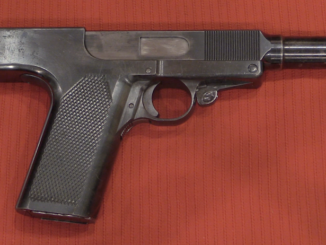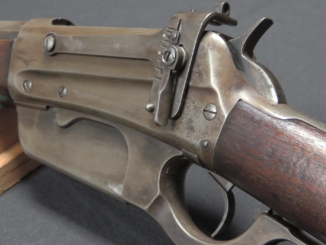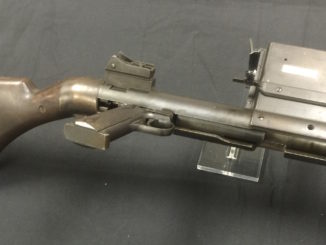After a series of pistol trials, Norway adopted a copy of the Colt 1911 in .45 ACP as its standard service pistol in 1914. A license was purchased from FN (while under German occupation, interestingly) to produce the guns locally at Kongsberg, and production ran slowly and sporadically until German occupation in WWII. At that point, the German military decided to continue production for German use (still in .45 ACP, the only pistol in that caliber formally used by the German military).
The Norwegian m/1914 pistols are mechanically identical to the Colt 1911 with the exception of an extended slide release lever. They are also serial numbered on all major parts, unlike US pistols.




no link in the description, oops. Were the occupation produced guns a poorer quality like the Krag rifles?
Just added the link. As far as I can tell, the production was pretty good – better than the occupation Krags.
I have handled a couple of them, both wartime production ones. Shot one of them as well.
I really liked the slide releases – I’m not much of a 1911 guy myself, but if I ever was to buy one, I would have a smith whip me up something like this.
Aside from that, it was not anything special, shooting wise.
This, and a Kongsberg converted Mauser Kar98K (in .30-06) could definitely be something for my collection. Some day.
Chanses are good that you some day will get your hands on a Kongsberg converted mauser. Actually there is a lot of them still in use and for sale here in Norway. When The Norwegian homeguard starter using the G3 (AG3) they almost litterally handed out the mausers for something around 50-60 USD.
The ones stamped with “Kar” was by the Kystartilleriet (coast artillery) and are the most rare of the mausers found today (but not uncommon). You will also find mausers stamped “hær” (army) and “fly” (air force).
Many of them are converted to hunting rifles. New stock, drilled holes in the reciever for scoupe mountings and new trigger grop. Most commonly the bolt handle is also re-shaped to open at a lower angle so that is does not hit the scope when fully lifted. The same goes with the safety at the backen of the bolt. Those mausers are probably the most common hunting rifle in norway of you look back a coupe of years
Original mauser (only converted to 30-06) marked “kar” would sell for around 300-400 USD.
Edit – the coast artillery mausers where of course marked “kart” (witch i read in the first place, thus the reason for my comment), and not “kar”
Well– wow! That was very interesting.
I had no idea. Thank you so much Ian for that exceptional presentation.
I assume “our” magazines would function in the Norwegian models.
So there are a few of these out there (somewhere) with the swastika and German eagle stamped on them.
When I was in Bosnia and Kosovo I think the Norwegian NATO troops had P-38s (if my memory serves me right).
Wonder when the Norwegian military transitioned away from the Cold .45?
Regards
Pat
The Norwegian Army standardized on the P.38 in 1959, when NATO called for all member nations to use the 9 x 19mm cartridge in pistols and SMGs. That was when production of the P.38 (as the P1, with aluminum frame) resumed at Walther’s new Ulm/Donau plant.
In 1999, they changed over to the Glock 17 in the same caliber.
https://en.wikipedia.org/wiki/List_of_equipment_of_the_Norwegian_Army
cheers
eon
Question: was the Norwegian M1914 manufactured with metric dimensions or American
Another question to go along with M1914 D’ data. Did Canadian made P35s have metric or English/American dimensions ?
AFAIK, no…9mm has always been marked as such…I recently wrote an article on the BHP for our collectors club, using R Blake Stevens book from Collector Grade Pubs as my main reference source and nowhere did I see any mixed designation for 9mm or its equivalent English measurement (whatever that might be) mentioned.
Take you Chris. However my question concerns the pistol’s D’ rather than the cartridge.
Were the manufacturing specifications changed from metric for the Canadian made P-35?
Were the 1911 specs changed to metric for Norwegian manufacture ?
interesting parallel to the Hi-Power, as the (semi) standard side-arm for the British Commandos and then later Canadian troops produced in Belgium, then when the factory got over-run and the Hi-Power was adopted by the Waffen SS a technical set was smuggled to Canada and we began supplying them for British and Commonwealth troops.
All of a sudden you had the best troops the Germans had and the best troops the Commonwealth had, all armed with the same side-arm.
Waffen-SS was were not the best troops the Germans had, and certainly not in the 1940 to 1941 timeframe. Early on Waffen-SS adopted many weapons which were not standard for the Army (Heer), simply because the Army had priority of standard weapons. After Stalingrad Hitler increasingly mistrusted the Army and at the same time started to favor the Waffen-SS, so the latter received increasingly larger amounts of the best weapons, but that had little to do with weapons adopted by the Waffen-SS prior to 1942. In any case, the best German infantry troops at least until 1945 were probably the 1st and 2nd Fallschirmjäger (Paratrooper) Divisions, which were Luftwaffe formations.
“Early on Waffen-SS adopted many weapons which were not standard for the Army (Heer), simply because the Army had priority of standard weapons.”
Also Waffen-SS get weapons from Czechoslovak factories, as it was considered not standard (as all standard firearms go to Wehrmacht) than actual namely:
ZB 26 as MG 26(t) – when Wehrmacht issued MG 34
PzB-41(t) repeating anti-tank rifle with unique method of operation
see: http://world.guns.ru/atr/de/pzb-mss41-e.html
ZK-383 submachine gun
I suspect that hastily formed militia units would have it worse than the SS. They’d be lucky to get panzerfausts and a working set of rifles at all…
If you are referring to the Volkssturm militia, then yes, they usually got a mishmash of captured weapons often chambered for non-standard calibers, and a very limited ammo supply for them. There’s even a probably apocryphal story about some militiamen in Berlin who were supposedly armed with Gewehr 71/84 rifles from some semi-forgotten depot. Towards the end is also became common to arm Volkssturm with hunting weapons gathered from various sources.
Back in the mid 60s or so my dad brought home one of these Norwegian 1914s…his story was that it was ‘given’ to him by a Fort Lee NJ, cop who knew of my dad’s interest in firearms (and who had ‘given’ him a few others in the past). At the time neither one of us was a ‘collector’, as such, but he knew it was unique because of the extended slide stop and the fact that it was not a US manufacture…in those days there was little information available to would be collectors/enthusiasts and of course, no world wide web. Remember also that all of this took p0lace in what is now the ‘People’s Demokratik Reopublik of NJ’ (but long before the Communists & Socialists took over…ownership of firearms was restricted but not as terribly badly as in is these days – I fled the PDRNJ in Ag of ’79 and moved to the Free State of FL. My dad & Mom moved here in Oct of that year, but unfortunately my dad sold all his firearms before moving, fearing that the firearms laws were MUCH WORSE in FL than in NJ…a simple call or letter to me couldda cleared that misunderstanding up right quick (I KNOW Pop got hosed, but since many of the firearms were allegedly’ free’ he was satisfied with his remuneration)…among the guns sold was the 1914 (he had a bunch of collectible stuff that got lost also) the only things that followed him down here w3as a Smith K-22 Mfd in early 1957 and a Mauser 1910/14 in .32 ACP…I lost the Mauser in pawn in the mid 80s but still have that classic K-22. Every time I see one of these I wanna cry (even at 66) because I(actually dad) had one and ‘lost’ it. Thanx for the video Ian…BTW OUR 1914 was blued.
That’s some funky checkering on the scales too.
Did Norway have a submachine gun between WWI and WWII, and if so was it in 9mm or 45 ACP?
BTW note that calibre on the slide is 11.25 mm, instead of a typical European recalculation – 11.43 mm. Fine exception.
11.43mm is simply conversion of inch to mm (.45*25.4 = 11.43)
when 11.25mm refers to internal barrel diameters (lands)
Of course, you are right. The Norwegians also have the right, .45 ACP is also (and perhaps above all) fine, but simple recalculation 11.43 mm is a little less fine by caliber definition. Everyone knows what .45ACP and what 11,43 mm are, but it is difficult to recalculate an American tradition in a simple way, and today it would require some courage to write cal. 11.25 mm in Europe. I like the Norwegian exception.
Recalculations like 11.43 mm were once common for military nomenclature, but these days they are rarely official any more, even if some people still use them. For example the official C.I.P. name for the .45 ACP cartridge is “45 Auto” (yes, without the preceding point). The notable exception, or actually not an exception but a different case, are the 6.35, 7.65 and 9 mm Browning (.25, .32 & .380 ACP) cartridges, which have had a metric name from the beginning in Europe. (9 mm Browning usually refers to 9x17mm, but technically it should be 9 mm Browning Court/Kurz/Short due to the existence of the 9 mm Browning Long)
After 1814 Notway was In a personal union with Sweden. The countries shared the king and foreign policy, but otherwise where separate states. In the late 1800s Norway pushed for independence. Amongst other things this meant building up the army and navy. As a result Norway had a state of the art army and a active arms industry when it peacefully broke away from Sweden in 1905.
After this crisis was resolved and war no longer a threat, Norway adopted a policy of neutrality, and the army no longer had priority.
As a result the Norwegian army faced the German army in 1940 with more or less the same equipment as it had in 1905; krag rifles,
During ww2, the free Norwegian was British equipped and trained,. They retained the British equipment until the late 50s when it was replaced by a combination of German surplus and US vehicles. The HK G3, produced under license at Kongsberg as the AG3, became the standard army rifle, along with mg3 LMGs, mp5 SMGs, and p38 pistols. The home guard retained recalibered mauser rifles, mp40s and mg34s into the 80s.
The current lineup is glock 17s, HK416, mp7, mg3s and Minims, with hk417 And Barrett m82 sniper rifles.
Note that the Norwegian-made G3 was a bit different that the standard model, in that it had no bolt-retractor up on the spring tunnel. Instead, it had an M3A1 “Grease Gun”-style finger hole in the bolt to haul the bolt back with.
cheers
eon
It also has a slightly longer stock, as far as I remember.
There is a updated version, the AG3 F2, with a top and handguard rail and a collapsible stock. (The F1 simply has the collapsible stock.)
The last ones are being fazed out by the home guard these days.
Eon, I have never seen a Norwegian G3 without the bolt-retractor.
The G3 bolt has a lever (Sperrhebel in German) under very heavy spring load to prevent rebounding when the bolt slams home. I doubt that even a very powerful soldier can retract a G3 bolt using a finger hole like the M3 submachine gun.
Norwegian G3 bolts do not have a finger hole, but are serrated in the area visible through the ejection opening. But this is intended to be able to close the bolt (against above metioned Sperrhebel) in a quiet way. Normal operation is retracting it fully and let it snap forward. If you let it go forward slowly (and quietly), it will not close completely. The serrations on the bolt carrier allow the soldier to push it completely into battery position.
I never handled a original G3, but if you are talking about the charging handle the AG3 most certainly has one.
“still in .45 ACP, the only pistol in that caliber formally used by the German military”
Does “formally used” to be equal with listed in Fremden Gerät?
If so also other pistol were used, according to:
http://www.axishistory.com/axis-nations/138-equipment/equipment/4257-fremden-geraet-captured-small-arms
Colt Mod 1911 as Pistole 660(a)
Colt Mod 1917 as Revolver 661(a)
Smith & Wesson Mod 1917 as Revolver 662(a)
I don’t know if “fremden Gerät” number alone qualifies. The Germans gave one to basically all foreign weapons they captured or otherwise acquired in any numbers higher than a few (I don’t know if there was an official lower limit).
The “Fremden Gerät” list was a german catalogue over foreign nations weapons i general, not a list of the foreign weapons captured and / or used by the germans.
Plus 200-500 “lunchbox specials” during the war for partisan use.
Or
One day I devised myself a plan
That should be the envy of most any man
I’d sneak it out of there in a lunchbox in my hand
Now gettin’ caught meant gettin’ killed
But I figured I’d have it all by the time I retired
I’d have me a colt worth at least a grand. 😉
Like!!! Unfortunately I find myself reaching for the ‘like’ button where there is NO SUCH thang…
Way cool, I used to own a 9mm Belgian Browning made during WWII while under Nazi occupation which had full matching serial numbers and the Waffen/Nazi Eagle acceptance stamps all over it (until my neighbor’s Druggie son stole it). One of these would have been even more of a collectors item. Shame that there was no photo of one of the Nazi copies of this weapon in this article.
Thinking about it, it is odd that Norway is the only or almost the only state to adopt the 1911 as a service pistol. At the time it was surely by far the best military pistol in the world, yet it had a rather disappointing record outside the USA. I wonder why this could have been?